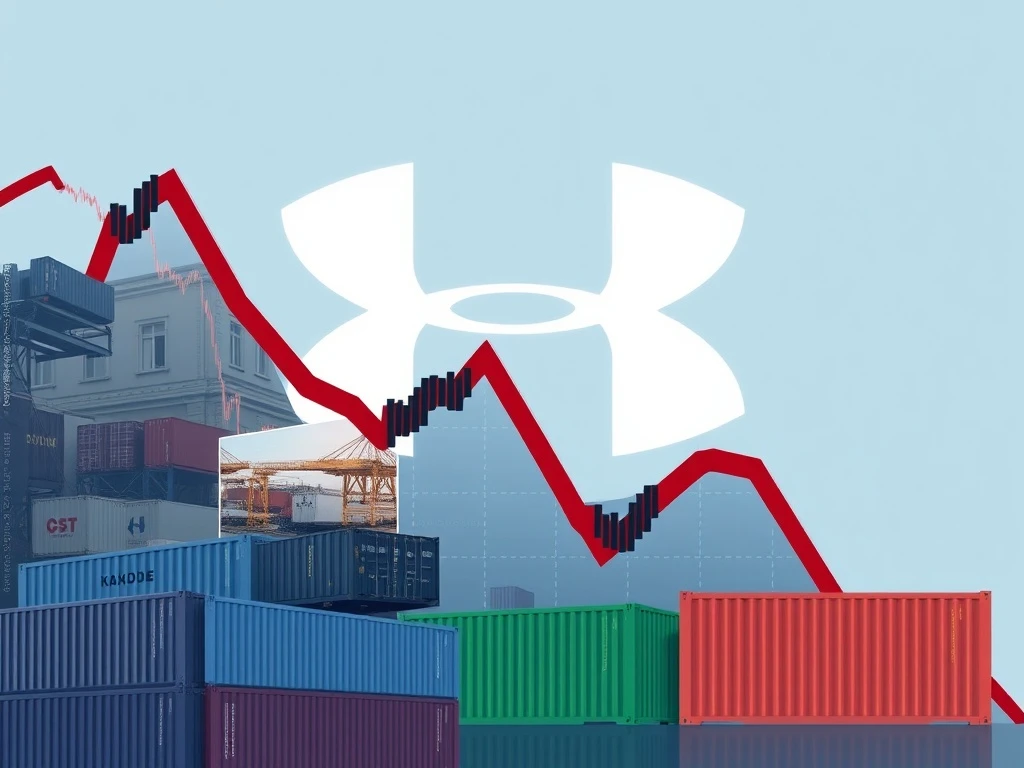Investors closely watch the financial markets. Recent news has sent shockwaves through the retail sector. Specifically, Under Armour stock experienced a significant downturn. This drop occurred after its CEO directly linked tariffs to a substantial hit on company profits. Such statements often signal broader economic concerns. They also highlight the tangible effects of global trade policies on corporate bottom lines. Understanding this situation provides crucial insights for anyone interested in business and entrepreneurship.
The Immediate Impact on Under Armour Stock
Under Armour, a prominent sportswear brand, saw its shares dive sharply. This happened shortly after its chief executive officer, Patrik Frisk, voiced concerns. He explicitly stated that ongoing tariffs were negatively affecting the company’s profitability. Consequently, investor confidence wavered. This led to a swift sell-off of shares. The market reacted quickly to these financial warnings. Such announcements often trigger immediate shifts in stock value. This situation underscores the volatility inherent in today’s global economy.
Furthermore, the CEO’s comments provided a stark outlook. He indicated that the trade disputes were creating significant headwinds. These headwinds directly impacted the company’s ability to maintain its profit margins. Many analysts began revising their forecasts. They adjusted their expectations for Under Armour’s future earnings. The company faces a complex challenge. It must navigate rising costs due to these trade barriers. Ultimately, this directly impacts the performance of Under Armour stock.
CEO’s Concerns and Financial Outlook
Patrik Frisk did not mince words. He expressed clear frustration over the tariff situation. These duties impose extra costs on goods imported from certain countries. For Under Armour, a company with extensive global supply chains, this means higher expenses. The company sources many of its products and materials from overseas. Thus, these additional costs directly erode profits. Frisk emphasized that these tariffs were not just a minor inconvenience. Instead, they posed a significant threat to the company’s financial health.
Moreover, the CEO detailed specific challenges. These included increased manufacturing costs and logistical complexities. Under Armour must either absorb these costs or pass them to consumers. Both options present difficulties. Absorbing costs shrinks profit margins. Passing costs to consumers could reduce demand. Therefore, the company faces a difficult balancing act. Its ability to manage these pressures will largely determine its future financial stability. This directly influences the trajectory of Under Armour stock.
Broader Retail Landscape and Trade Wars
Under Armour is not an isolated case. Many companies in the retail sector grapple with similar issues. The ongoing trade disputes, particularly between the United States and China, have created widespread uncertainty. Tariffs are taxes on imported goods. They aim to make foreign products more expensive. This theoretically encourages domestic production. However, many U.S. companies rely heavily on global supply chains. They manufacture goods in countries like China due to lower labor costs and established infrastructure.
Consider these key impacts of tariffs on retail:
- Increased Costs: Retailers face higher expenses for imported goods.
- Supply Chain Disruptions: Companies must find new suppliers or reconfigure existing networks.
- Reduced Profit Margins: Higher costs eat into a company’s earnings.
- Consumer Price Hikes: Some costs are passed to shoppers, potentially dampening demand.
Consequently, these factors create a challenging environment. The entire retail industry feels the pressure. Under Armour’s situation reflects a broader trend. Companies must adapt quickly to evolving trade policies. This continuous adaptation impacts their operational strategies and financial performance.
Analyzing Under Armour Stock Performance
The immediate reaction to the CEO’s statements was a sharp decline in Under Armour stock value. This reflects investor apprehension. Shareholders become nervous when a company’s profitability is threatened. A stock’s value often mirrors market sentiment about a company’s future earnings potential. When that potential seems diminished, investors frequently sell off shares. This drives the price down.
Historically, stock prices are sensitive to economic indicators. Trade policies represent a significant economic factor. For instance, positive trade news can boost investor confidence. Conversely, negative news, like tariff impacts, can trigger declines. Under Armour’s stock performance highlights this sensitivity. Its recent dip serves as a cautionary tale for companies with global supply chains. Maintaining transparency with investors during such times becomes crucial. It helps manage expectations and mitigate panic selling.
Investor Reaction and Market Volatility
Investors reacted swiftly to the news. Large institutional investors and individual shareholders alike began selling their positions. This collective action amplified the stock’s decline. Market volatility increased. Such periods of high volatility are common during economic uncertainty. They can present both risks and opportunities. However, for current shareholders, the immediate impact was negative. They saw the value of their holdings decrease.
Furthermore, market analysts quickly downgraded their ratings for Under Armour. This further fueled the negative sentiment. Downgrades often signal a belief that the company’s future performance will be weaker than previously expected. These expert opinions influence other investors. They can accelerate a stock’s downward trend. Therefore, the combination of CEO warnings and analyst downgrades created a perfect storm for Under Armour stock.
Strategies for Mitigating Tariff Effects
Companies facing tariff challenges employ various strategies. Under Armour, like others, must consider these options. Diversifying supply chains is one key approach. This involves shifting production to countries not subject to tariffs. However, this process can be complex and costly. It requires establishing new relationships and infrastructure. Another strategy involves lobbying efforts. Companies can advocate for changes in trade policy. They work with government officials to highlight the negative impacts of tariffs.
Moreover, companies may explore price adjustments. They might slightly increase product prices to offset higher import costs. This strategy carries risks. Consumers might opt for cheaper alternatives. Innovation also plays a role. Developing new, high-value products can justify higher prices. Ultimately, a multi-faceted approach is often necessary. This helps mitigate the long-term impact of tariffs. Such proactive measures can help stabilize Under Armour stock in the future.
Future Outlook for Under Armour Stock and the Apparel Industry
The future of Under Armour stock remains tied to several factors. Resolution of trade disputes is paramount. A reduction or elimination of tariffs would significantly ease the pressure on the company. This would lower operational costs. It would also improve profit margins. However, predicting trade policy outcomes is difficult. Companies must plan for various scenarios.
Beyond tariffs, consumer demand also shapes the outlook. The sportswear market remains competitive. Under Armour must continue to innovate. It needs to create desirable products. Strong brand loyalty and effective marketing campaigns are essential. These factors can help the company navigate economic headwinds. They can also support a rebound in its stock price. Ultimately, the company’s resilience and strategic agility will determine its long-term success.
The apparel industry as a whole faces evolving challenges. E-commerce growth, sustainability demands, and changing consumer preferences are constant pressures. Companies like Under Armour must adapt continually. Their ability to innovate, manage costs, and respond to market shifts will define their trajectory. Investors will watch closely. They will assess how well Under Armour navigates these complex dynamics. This will impact the ongoing performance of Under Armour stock.
In conclusion, Under Armour’s recent stock decline underscores the direct impact of global trade policies on corporate profitability. The CEO’s clear warnings about tariffs highlight a significant challenge. This situation affects not only Under Armour but also the broader retail sector. Companies must adopt robust strategies to mitigate these effects. The long-term performance of Under Armour stock will depend on trade policy resolutions and the company’s strategic responses to market dynamics.
Frequently Asked Questions (FAQs)
1. Why did Under Armour stock drop recently?
Under Armour stock dropped after its CEO, Patrik Frisk, stated that ongoing tariffs were negatively impacting the company’s profit margins. This news caused investors to sell shares, leading to a decline in stock value.
2. What are tariffs and how do they affect companies like Under Armour?
Tariffs are taxes imposed on imported goods. For companies like Under Armour, which rely on global supply chains for manufacturing, tariffs increase the cost of sourcing products and materials. This directly reduces their profit margins.
3. Is Under Armour the only company affected by tariffs?
No, Under Armour is not alone. Many companies in the retail and apparel sectors, especially those with extensive international supply chains, are grappling with increased costs and supply chain disruptions due to global trade disputes and tariffs.
4. What strategies can Under Armour use to mitigate tariff impacts?
Under Armour can employ several strategies, including diversifying its supply chains by shifting production to non-tariffed countries, lobbying government officials for policy changes, and potentially making slight price adjustments to products.
5. What is the long-term outlook for Under Armour stock?
The long-term outlook for Under Armour stock depends heavily on the resolution of global trade disputes and the company’s ability to adapt. Continued innovation, strong brand management, and effective cost control will also be crucial for its future performance and potential stock recovery.
























